Anthelmintic Drugs Market Research, 2032
The global anthelmintic drugs market size was valued at $1 billion in 2022, and is projected to reach $1.5 billion by 2032, growing at a CAGR of 3.8% from 2023 to 2032. The growth of the anthelmintic drugs market is attributed to growing prevalence of helminths infections around the globe. For instance, according to an article by World Health Organization (WHO) published in January 2023, soil-transmitted helminth (STH) infections are among the most common infections worldwide with an estimated 1.5 billion infected people or 24% of the world’s population. These infections target the most vulnerable and impoverished communities with limited access to safe water, sanitation, and hygiene. Such huge incidences of helminth infections increase the demand for anthelmintic drugs. This propels the anthelmintic drugs market share.
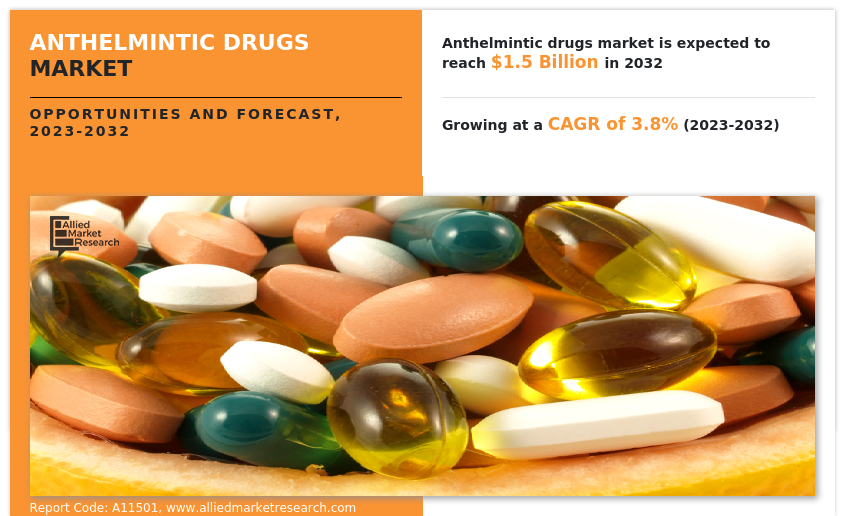
Key Takeaways:
The benzimidazole segment dominated the global market in 2022.
The macrocyclic lactones segment is anticipated to be the fastest-growing segment during the forecast period.
The nematode infections segment dominated the market in terms of revenue in 2022.
The drug stores & retail pharmacies segment dominated the market in terms of revenue in 2022.
The North America region dominated the market in terms of revenue in 2022.
Anthelmintics are drugs that are specifically designed to fight infections caused by parasites. These parasites are called helminths and are found in many different places on the body. They can infest the intestines, lungs, or even the body tissues. Anthelmintics work by targeting these parasites and helping to flush it out of the body. Alternatively, it works by disrupting the parasites’ metabolic processes, which results in the parasites being destroyed or expelled from the body. There are many different classes of anti-helminth drugs with unique way of action against the different types of parasites.
Market Dynamics
The growth of the anthelmintic drugs market size is attributed to rise in prevalence of parasitic infections, surge in awareness among people regarding early disease diagnosis and preventive measures for parasitic infections drives and availability of generic drugs. The need for anthelmintic drugs is driven by the growing awareness of preventive measures against helminth infections. People and communities become more aware of the risks of helminths infection as public education and healthcare campaigns highlight the importance of prevention. This increased awareness leads to more proactive measures to prevent these parasitic diseases, such as better hygiene, sanitation, and targeted treatments.
The prevalence of parasitic infections is a significant factor influencing the demand for anthelmintic drugs. Helminths are parasitic infections caused by worms. Millions of people around the world suffer from these infections, which can lead to serious health problems and economic losses. These infections are found in many different parts of the world, especially in countries with poor hygiene, poor sanitation, and poor access to health care.
In addition, the availability of generic medications plays a pivotal role in propelling anthelmintic drugs market size. Generic drugs are pharmaceutical equivalents of brand-name medications but are produced and marketed after the patent expiration of the original drug. The availability of generic versions provides several advantages, including cost-effective alternatives to branded medications, significantly reducing treatment expenses for individuals and healthcare systems.
However, the affordability of anthelmintic drugs poses a substantial challenge, particularly in low-income regions where access to healthcare resources is limited. In certain rural areas of sub-Saharan Africa, where parasitic worm infections like schistosomiasis or soil-transmitted helminthiasis (STH) are prevalent, individuals often face financial constraints that hinder their ability to afford anthelmintic treatments. This may hamper market growth to some extent.
A recession denotes a phase characterized by a reduction in economic activity, often encompassing decline in various economic indicators. During a recession, there might be decrease in research funding, both from government sources and private institutions. In addition, there is typically a contraction in economic activity, leading to reduced consumer spending, decreased business investments, and potential job losses. This economic downturn may affect healthcare budgets, including funding for anthelmintic drugs.
The pharmaceutical industry is expected to face challenges in terms of R&D funding and market demand. A recession can impact the financial resources available for drug development and slow down the introduction of new anthelmintic drugs. Concerns about affordability of these medications may become more prominent during a recession. High drug prices are a persistent issue, and economic hardships may intensify calls for drug pricing reforms.
Segmental Overview
The anthelmintic drugs market is segmented on the basis of drug class, infection type, distribution channel, and region. On the basis of drug class, the market is segmented into benzimidazoles, macrocyclic lactones, pyrazinoisoquinolones, tetrahydropyrimidines and others. On the basis of infection type, the market is segmented into nematode infections, cestode infections, trematode infections and mixed infections. Based on distribution channel, the market is segmented into hospital pharmacies, drug stores & retail pharmacies and online providers. Region-wise, the market is analyzed across North America (the U.S., Canada, and Mexico), Europe (Germany, France, the UK, Italy, Spain, and rest of Europe), Asia-Pacific (China, Japan, Australia, India, South Korea, and rest of Asia-Pacific), and LAMEA (Brazil, South Africa, Saudi Arabia, and rest of LAMEA).
By Drug Class
Based on drug class, the benzimidazoles segment held the largest anthelmintic drugs market share and is anticipated to maintain its dominance during the forecast period. The benzimidazoles segment accounted for largest share in 2022 and is anticipated to remain dominant during the forecast period. This is attributed to broad-spectrum activity of benzimidazoles such as albendazole and mebendazole against various parasitic worms, offering efficacy against a wide range of infections. Their effectiveness in treating common parasitic infections such as roundworms, tapeworms and certain flukes has positioned them as a go-to choose for many healthcare providers and veterinarians in managing different parasitic infestations.
However, the macrocyclic lactones segment is projected to register fastest CAGR during the forecast period, owing to their efficacy against a broad spectrum of parasites, including both internal and external parasites. In addition, ongoing research and development efforts focusing on novel formulations and delivery methods for macrocyclic lactones have expanded their applications and improved their effectiveness. Innovations such as extended-release formulations and novel combinations with other active ingredients have enhanced the drug's efficiency, aiding in more prolonged protection against parasitic infestations. Moreover, increased awareness of parasite resistance to existing treatments has driven the adoption of macrocyclic lactones, propelling the anthelmintic drugs market growth.
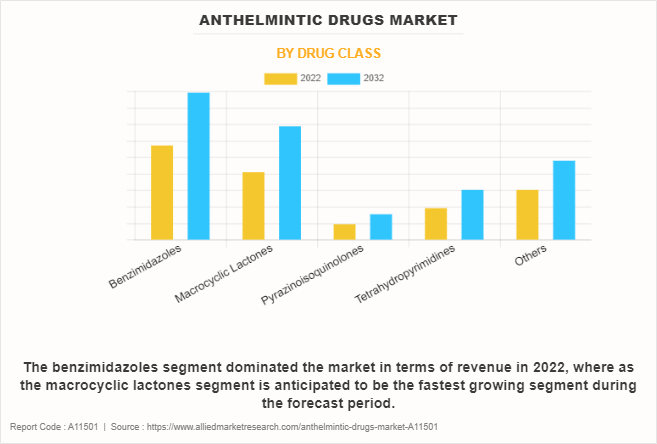
By Infection Type
Based on infection type, the nematode infections segment accounted for largest share in 2022 and is anticipated to register fastest CAGR during the forecast period. Nematode infections represent a significant public health concern globally, affecting millions of people, particularly in tropical and subtropical regions. These infections encompass a broad spectrum of diseases, including intestinal nematodes such as roundworms, whipworms, and hookworms, as well as filarial infections causing conditions such as lymphatic filariasis and onchocerciasis. The high prevalence of these infections in many parts of the world has resulted in a sustained demand for effective anthelmintic medications dedicated to combating nematodes in humans.
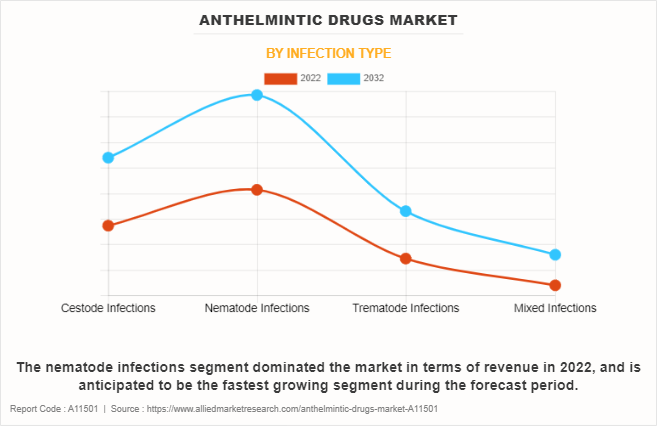
By Distribution Channel
By distribution channel, the drug stores and retail pharmacies segment accounted for largest share in 2022 and is expected to remain dominant during the forecast period owing to growing preference of people towards these pharmacies. These pharmacies serve as accessible points of contact for individuals seeking guidance on medications and their proper usage during treatment. In addition, these pharmacies often have pharmacists available to offer advice, educate patients about anthelmintic medications, and ensure their proper administration. Furthermore, the convenience factor plays a significant role as these retail pharmacies are widespread and easily accessible to the general population, encouraging individuals to seek treatment and purchase anthelmintic drugs conveniently.
On the other hand, the online providers segment is anticipated to be the fastest growing segment during the forecast period. The online providers segment is projected to register the highest CAGR during the forecast period owing to the rise in popularity of online pharmacy and number of users preferring online pharmacies.
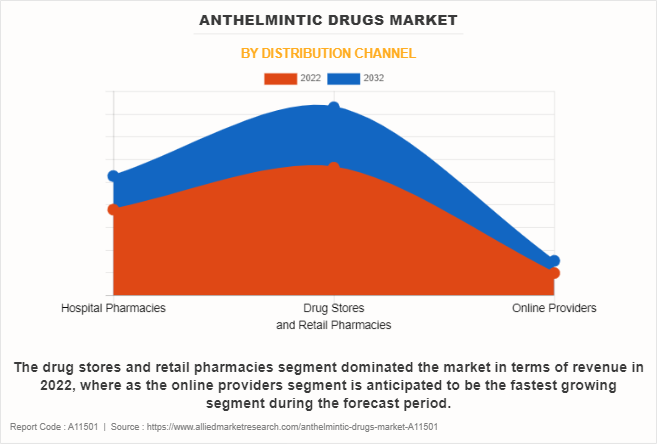
By Region
The anthelmintic drugs market is analyzed across North America, Europe, Asia-Pacific, and LAMEA. The anthelmintic drugs market in North America is growing due to several factors, including high prevalence of parasitic infections and sufficient awareness among the people regarding preventive measures for parasitic infections. The region also has a well-established healthcare system, access to cutting-edge diagnostic technologies, and strict regulatory standards that increases the number of diagnostic tests for parasitic infections which increases the demand for anthelmintic drugs for treatment of the infection. Furthermore, the increasing cost of healthcare, the emphasis on early detection and prevention of diseases.
On the other hand, the Asia-Pacific region is anticipated to be the fastest growing segment during the forecast period. The anthelmintics market in the Asia-Pacific region is driven by several factors including rising incidences of parasitic infections in this region. According to World Health Organization (WHO), soil-transmitted helminth (STH) infections affect the poorest and most deprived communities with poor access to clean water, sanitation and hygiene in tropical and subtropical areas, with the highest prevalence reported from China, and Asia. Thus, there is a significant demand for these anthelmintic medications in developing regions which contributes to the market growth in this region. In addition, a high population base and developing healthcare infrastructure is also contributing to the market growth durign the anthelmintic drugs market forecast period.
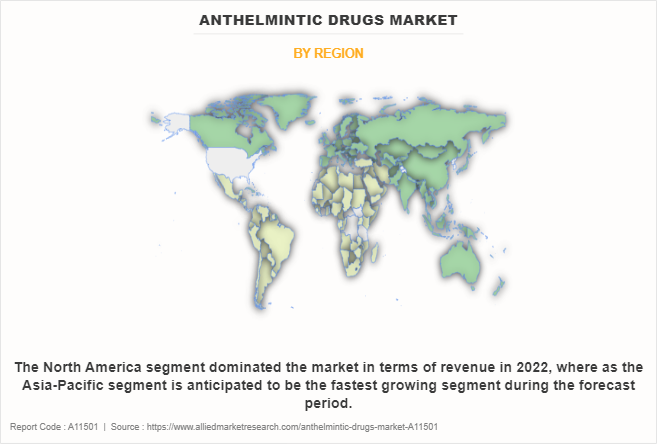
Competition Analysis
Competition analysis and profiles of the major players in the anthelmintic drugs industry, such as Major players profiled in this report are GlaxoSmithKline plc, Johnson & Johnson, Merck & Co., Inc., Bayer AG, Cipla Ltd., Sun Pharmaceutical Industries Ltd., Teva Pharmaceutical Industries Limited, Reese Pharmaceutical Company, and Zydus Lifesciences Limited. Other key players in the market include Cadila Pharmaceuticals, Regulus, John Lee, Mediva, Intas Pharmaceuticals, Abigail, J B Chemicals and Pharmaceuticals Ltd, Mankind Pharma Ltd and others.
Key Benefits for Stakeholders
- This report provides a quantitative analysis of the market segments, current trends, estimations, and dynamics of the anthelmintic drugs market analysis from 2022 to 2032 to identify the prevailing anthelmintic drugs market opportunity.
- The market research is offered along with information related to key drivers, restraints, and opportunities.
- Porter's five forces analysis highlights the potency of buyers and suppliers to enable stakeholders make profit-oriented business decisions and strengthen their supplier-buyer network.
- In-depth analysis of the anthelmintic drugs industry segmentation assists to determine the prevailing market opportunities.
- Major countries in each region are mapped according to their revenue contribution to the global market.
- Market player positioning facilitates benchmarking and provides a clear understanding of the present position of the market players.
- The report includes the analysis of the regional as well as global anthelmintic drugs market trends, key players, market segments, application areas, and market growth strategies.
Anthelmintic Drugs Market Report Highlights
| Aspects | Details |
| Market Size By 2032 | USD 1.5 billion |
| Growth Rate | CAGR of 3.8% |
| Forecast period | 2022 - 2032 |
| Report Pages | 250 |
| By Drug Class |
|
| By Infection Type |
|
| By Distribution Channel |
|
| By Region |
|
| Key Market Players | Bayer AG, Teva Pharmaceutical Industries Limited, Cipla Ltd., Zydus Lifesciences Limited, Johnson & Johnson, GlaxoSmithKline plc, Reese Pharmaceutical Company, Amneal Pharmaceuticals LLC, Sun Pharmaceutical Industries Ltd., Merck & Co., Inc. |
Analyst Review
The growing prevalence of parasitic infections around the world, especially in countries with poor sanitation and limited access to healthcare is the major factor boosting the market growth. This increase in prevalence of parasitic infections caused by helminths like roundworms, tapeworms and flukes highlights the need for efficient treatment options, driving the market for anthelmintic drugs.
In addition, increase in awareness of these infections, combined with efforts to promote healthcare education and preventative measures, technological advances in drug formulation, diagnostics and treatment methods also leads to the expansion of the anthelmintic drugs market.
Furthermore, the growing focus on R&D, in combination with partnerships between pharma companies and research institutes, is paving the way for breakthrough discoveries, creating an environment conducive to novel and improved anti-parasite therapies. Taking advantage of these opportunities is essential for addressing the untapped medical demand for parasitic infections and setting the market up for long-term growth.
The North America region dominated the market in terms of revenue in 2022, whereas the Asia-Pacific region is anticipated to be the fastest growing region during the forecast period. Rapidly developing economies within Asia-Pacific, coupled with growing healthcare investments and rising awareness about parasitic infections, are expected to drive substantial market growth.
The forecast period for anthelmintic drugs market is 2023 to 2032.
The total market value of anthelmintic drugs market is $1.0 million in 2022.
The market value of anthelmintic drugs market in 2032 is $1.5 million.
The base year is 2022 in anthelmintic drugs market.
Major players profiled in this report are GlaxoSmithKline plc, Johnson & Johnson, Merck & Co., Inc., Bayer AG, Cipla Ltd., Sun Pharmaceutical Industries Ltd., Teva Pharmaceutical Industries Limited, Reese Pharmaceutical Company, and Zydus Lifesciences Limited.
The benzimidazole segment is the most influencing segment in the market as there is a significant adoption of albendazole and mebendazole for treatment of parasitic infections.
Key factors driving the growth of the anthelmintic drugs market includes rising incidences of parasitic infections, growing awareness of preventive measures against helminth infections and availability of generic medications.
Asia-Pacific has the highest growth rate in the market owing to to high incidences of parasitic infections particularly in developing countries where sanitation and healthcare services are scarce. In addition, the high population base, rising healthcare expenditure and rising awareness among the population for early infection diagnosis and treatment are also contributing to the segment growth in this region.
Loading Table Of Content...
Loading Research Methodology...



